人教版七年级下册Unit2 What time do you go to school?单元重要知识点讲义课件(共28张PPT)
文档属性
| 名称 | 人教版七年级下册Unit2 What time do you go to school?单元重要知识点讲义课件(共28张PPT) |  | |
| 格式 | pptx | ||
| 文件大小 | 2.5MB | ||
| 资源类型 | 教案 | ||
| 版本资源 | 人教新目标(Go for it)版 | ||
| 科目 | 英语 | ||
| 更新时间 | 2023-02-27 14:56:21 | ||
图片预览


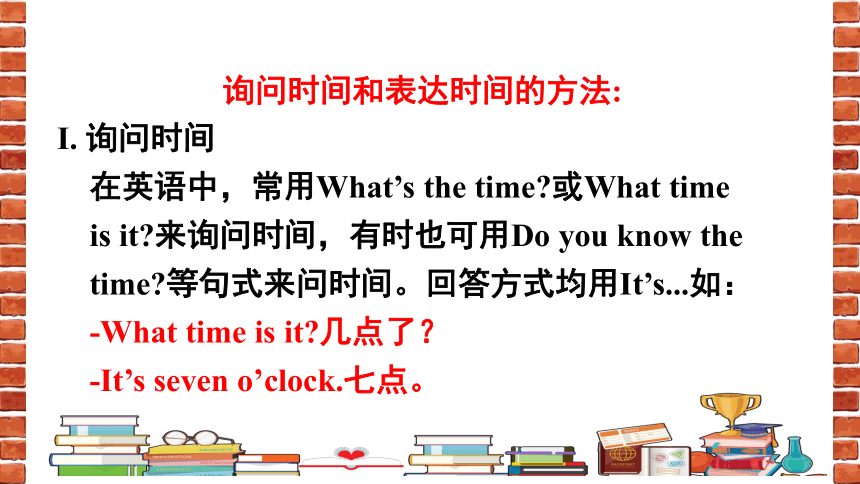
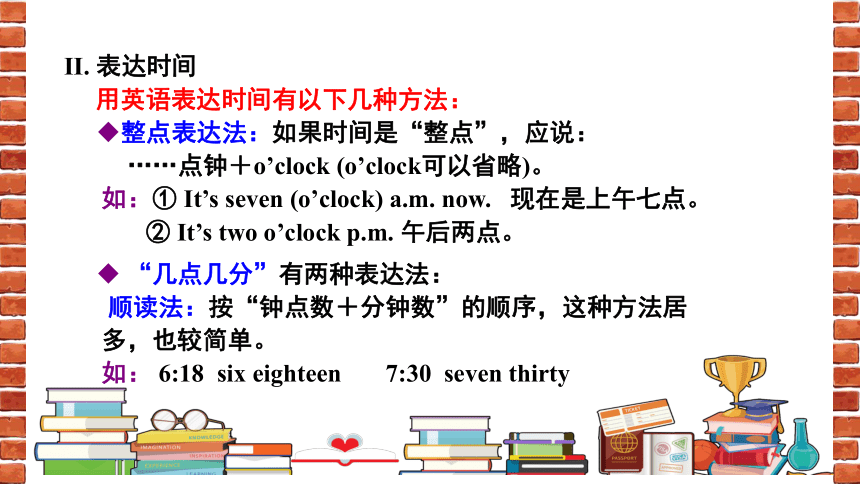
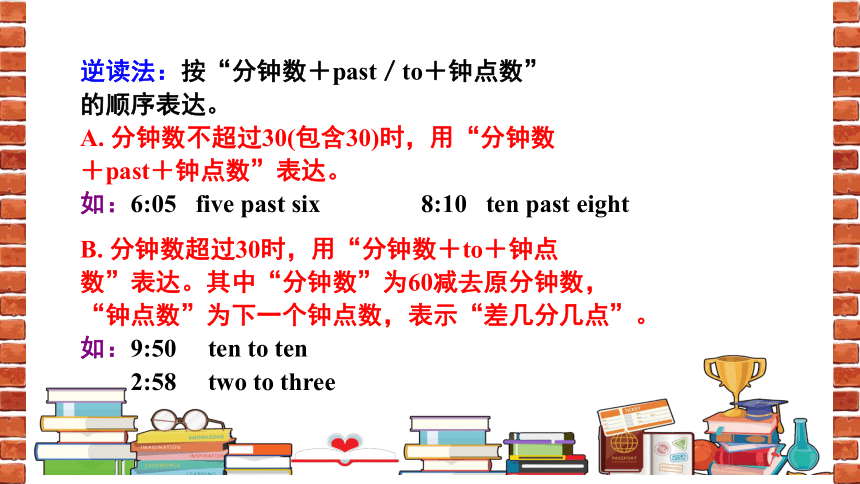

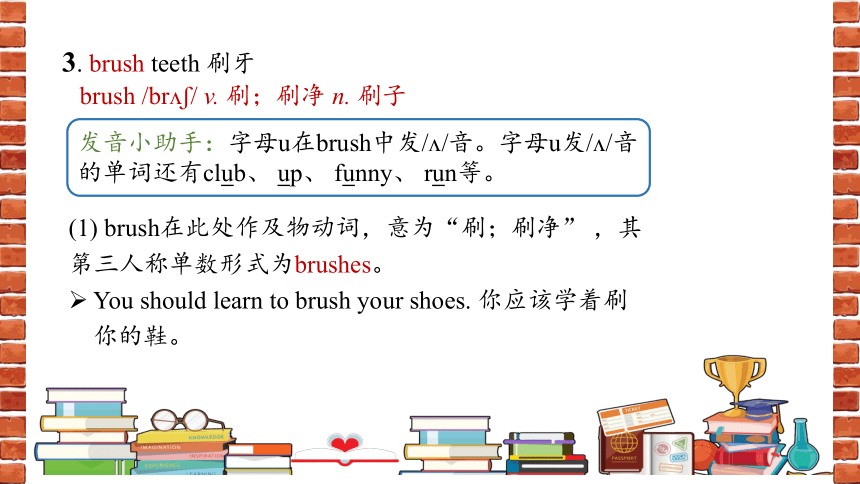
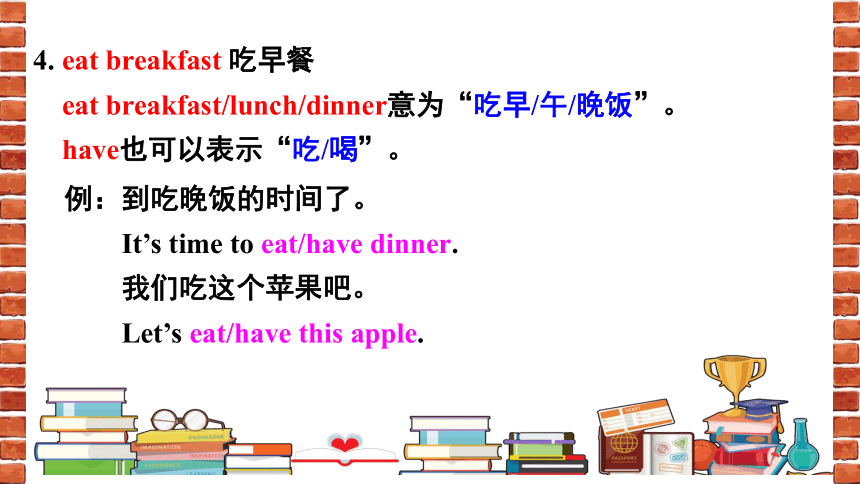
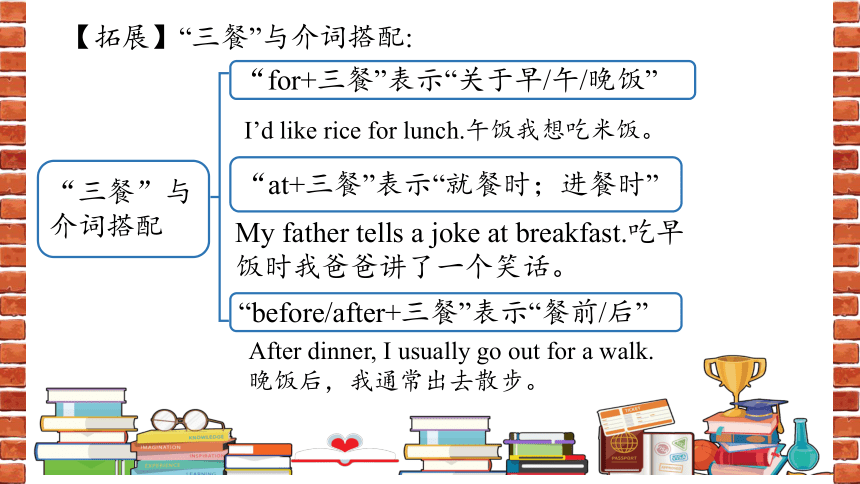
文档简介
(共28张PPT)
Unit 2 What time do you go to school
重要知识点讲义
1. What time do you usually get up, Rick
what time与when都可用于询问时间。但what time
所问的时间范围较小, 一般询问比较精确的时间;
而when(什么时候) 所问的时间范围比what time要大,
可询问小的时间点, 也可询问日期。
询问时间和表达时间的方法:
I. 询问时间
在英语中,常用What’s the time 或What time
is it 来询问时间,有时也可用Do you know the
time 等句式来问时间。回答方式均用It’s...如:
-What time is it 几点了?
-It’s seven o’clock.七点。
II. 表达时间
用英语表达时间有以下几种方法:
整点表达法:如果时间是“整点”,应说:
……点钟+o’clock (o’clock可以省略)。
如:① It’s seven (o’clock) a.m. now. 现在是上午七点。
② It’s two o’clock p.m. 午后两点。
“几点几分”有两种表达法:
顺读法:按“钟点数+分钟数”的顺序,这种方法居
多,也较简单。
如: 6:18 six eighteen 7:30 seven thirty
逆读法:按“分钟数+past/to+钟点数”
的顺序表达。
A. 分钟数不超过30(包含30)时,用“分钟数
+past+钟点数”表达。
如:6:05 five past six 8:10 ten past eight
B. 分钟数超过30时,用“分钟数+to+钟点
数”表达。其中“分钟数”为60减去原分钟数,
“钟点数”为下一个钟点数,表示“差几分几点”。
如:9:50 ten to ten
2:58 two to three
2. get dressed意为“穿上衣服”,强调穿衣的
动作,其后不能直接跟衣服类的名词作宾语。
例:起床穿衣服了!
Get up and get dressed!
3. brush teeth 刷牙
brush /br / v. 刷;刷净 n. 刷子
发音小助手:字母u在brush中发/ /音。字母u发/ /音的单词还有club、 up、 funny、 run等。
(1) brush在此处作及物动词,意为“刷;刷净” ,其第三人称单数形式为brushes。
You should learn to brush your shoes. 你应该学着刷你的鞋。
4. eat breakfast 吃早餐
eat breakfast/lunch/dinner意为“吃早/午/晚饭”。
have也可以表示“吃/喝”。
例:到吃晚饭的时间了。
It’s time to eat/have dinner.
我们吃这个苹果吧。
Let’s eat/have this apple.
【拓展】“三餐”与介词搭配:
“三餐”与介词搭配
“for+三餐”表示“关于早/午/晚饭”
“at+三餐”表示“就餐时;进餐时”
My father tells a joke at breakfast.吃早饭时我爸爸讲了一个笑话。
“before/after+三餐”表示“餐前/后”
After dinner, I usually go out for a walk.晚饭后,我通常出去散步。
I’d like rice for lunch.午饭我想吃米饭。
频度副词表示“多久一次”,是一种表示频繁程度的副词。常见频度副词按频率大小排列如下:
频度副词
usually
always
从不
很少
有时
经常
通常
总是
0%
20%
40%
60%
80%
100%
seldom
sometimes
(一)常见频度副词
频度副词一般放在实义动词之前,be动词、助动词或情态动词之后。
例:我通常八点半洗淋浴
I ______ _____ _____ ______ at eight thirty.
露西有时很忙。
Lucy _________ _________ very busy.
频度副词的位置:
usually take a shower
is sometimes
My mother always gets up early. 我妈妈总是起床很早。
I usually go to bed at 10:00 every night. 我通常每天晚上十点上床睡觉。
They often play soccer on weekends. 他们经常在周末踢足球。
John sometimes comes late. 约翰有时候会迟到。
My sister seldom play computer games. 我妹妹很少玩电脑游戏。
I never eat junk food. 我从不吃垃圾食品。
5. half past six in the morning 早上六点半
half 可作可数名词或代词,意为“一半;半数”,其复数形式为halves。常见搭配有:
half a year = a half year 半年
half an hour = a half hour 半小时
我们把这个苹果切成两半吧。
Let’s cut the apple in half.
十的一半是五。
Half of ten is five.
两个一半成一个整体。
Two halves make a whole.
past 在此处作介词,意为“晚于;过(时间)”。
现在是七点二十分。
It is twenty past seven now.
拓
展
past 的其他用法:
副词
名词
形容词
意为“经过”
意为“过去,往事”
意为“过去的”
I saw the accident when I walked past.
He traveled a lot in the past.
Great changes have taken place in the past ten years.
6. a quarter past three in the afternoon
下午三点十五
quarter 作名词,意为“一刻钟;四分之一”。
他一刻钟之后到达。
He arrives after a quarter.
把蛋糕切成四等份。
Cut the cake into quarters.
拓
展
当用 quarter 表达分数时,如果分子大于1,则 quarter 要用复数形式。
我们四分之三的同学都擅长打篮球。
Three quarters of our classmates are good at basketball.
7. They usually eat dinner at a quarter to seven in
the evening. 他们通常晚上六点四十五分吃晚饭。
用 past 或 to 表达英语钟点时刻时,
需要用“分钟+past/to+点钟”表示。
分钟+past+点钟(分钟小于或等于30)
表示“几点过几分”
(60-分钟)+to+(点钟+1)(分钟大于30)
表示“差几分几点”
8. eat quickly 吃得快
quickly 副词,意为“很快地”,强调思维或动作快。其形容词为 quick,意为“快的”。
他走得很快。
He walks very quickly.
他很快地完成了任务。
He finished his task quickly.
拓
展
(1)quick 的相关词:
quick adj.快的
slowly adv.缓慢地
quickly adv.很快地
slow adj.慢的
+ -ly
+ -ly
(2)形容词在词尾加 –ly 构成副词的还有:
sad 难过的
easy 容易的
quiet 安静的
happy 幸福的
sadly 难过地
easily 容易地
quietly 安静地happily 幸福地
+ -ly
9. After school, I sometimes play basketball for half an hour.
sometimes是副词,意为“有时”。
例:他有时和我哥哥一起踢足球。
He sometimes plays football with my brother.
10. I have a very healthy life. 我过着非常健康的生活。
healthy 健康的,相当于fit,既可作定语也可作表语。
例:你应该吃健康食品。
You should eat healthy food.
那位老人看起来很健康。
The old woman looks very healthy.
作定语
作表语
(广东深圳中考)
—Hi, John! Would you like to go hiking with me tomorrow
—Sounds great! It’s a good way to keep fit.
(同义替换)
A. lively B. active C. healthy
11. Here are your clothes. 这是你的衣服。
此句是here引导的倒装句。
当副词here, there等位于句首且主语为名词时,句子要完全倒装(谓语动词出现在主语之前)。
例:公交车来了!
Here comes the bus!
Thanks for your attention!
Unit 2 What time do you go to school
重要知识点讲义
1. What time do you usually get up, Rick
what time与when都可用于询问时间。但what time
所问的时间范围较小, 一般询问比较精确的时间;
而when(什么时候) 所问的时间范围比what time要大,
可询问小的时间点, 也可询问日期。
询问时间和表达时间的方法:
I. 询问时间
在英语中,常用What’s the time 或What time
is it 来询问时间,有时也可用Do you know the
time 等句式来问时间。回答方式均用It’s...如:
-What time is it 几点了?
-It’s seven o’clock.七点。
II. 表达时间
用英语表达时间有以下几种方法:
整点表达法:如果时间是“整点”,应说:
……点钟+o’clock (o’clock可以省略)。
如:① It’s seven (o’clock) a.m. now. 现在是上午七点。
② It’s two o’clock p.m. 午后两点。
“几点几分”有两种表达法:
顺读法:按“钟点数+分钟数”的顺序,这种方法居
多,也较简单。
如: 6:18 six eighteen 7:30 seven thirty
逆读法:按“分钟数+past/to+钟点数”
的顺序表达。
A. 分钟数不超过30(包含30)时,用“分钟数
+past+钟点数”表达。
如:6:05 five past six 8:10 ten past eight
B. 分钟数超过30时,用“分钟数+to+钟点
数”表达。其中“分钟数”为60减去原分钟数,
“钟点数”为下一个钟点数,表示“差几分几点”。
如:9:50 ten to ten
2:58 two to three
2. get dressed意为“穿上衣服”,强调穿衣的
动作,其后不能直接跟衣服类的名词作宾语。
例:起床穿衣服了!
Get up and get dressed!
3. brush teeth 刷牙
brush /br / v. 刷;刷净 n. 刷子
发音小助手:字母u在brush中发/ /音。字母u发/ /音的单词还有club、 up、 funny、 run等。
(1) brush在此处作及物动词,意为“刷;刷净” ,其第三人称单数形式为brushes。
You should learn to brush your shoes. 你应该学着刷你的鞋。
4. eat breakfast 吃早餐
eat breakfast/lunch/dinner意为“吃早/午/晚饭”。
have也可以表示“吃/喝”。
例:到吃晚饭的时间了。
It’s time to eat/have dinner.
我们吃这个苹果吧。
Let’s eat/have this apple.
【拓展】“三餐”与介词搭配:
“三餐”与介词搭配
“for+三餐”表示“关于早/午/晚饭”
“at+三餐”表示“就餐时;进餐时”
My father tells a joke at breakfast.吃早饭时我爸爸讲了一个笑话。
“before/after+三餐”表示“餐前/后”
After dinner, I usually go out for a walk.晚饭后,我通常出去散步。
I’d like rice for lunch.午饭我想吃米饭。
频度副词表示“多久一次”,是一种表示频繁程度的副词。常见频度副词按频率大小排列如下:
频度副词
usually
always
从不
很少
有时
经常
通常
总是
0%
20%
40%
60%
80%
100%
seldom
sometimes
(一)常见频度副词
频度副词一般放在实义动词之前,be动词、助动词或情态动词之后。
例:我通常八点半洗淋浴
I ______ _____ _____ ______ at eight thirty.
露西有时很忙。
Lucy _________ _________ very busy.
频度副词的位置:
usually take a shower
is sometimes
My mother always gets up early. 我妈妈总是起床很早。
I usually go to bed at 10:00 every night. 我通常每天晚上十点上床睡觉。
They often play soccer on weekends. 他们经常在周末踢足球。
John sometimes comes late. 约翰有时候会迟到。
My sister seldom play computer games. 我妹妹很少玩电脑游戏。
I never eat junk food. 我从不吃垃圾食品。
5. half past six in the morning 早上六点半
half 可作可数名词或代词,意为“一半;半数”,其复数形式为halves。常见搭配有:
half a year = a half year 半年
half an hour = a half hour 半小时
我们把这个苹果切成两半吧。
Let’s cut the apple in half.
十的一半是五。
Half of ten is five.
两个一半成一个整体。
Two halves make a whole.
past 在此处作介词,意为“晚于;过(时间)”。
现在是七点二十分。
It is twenty past seven now.
拓
展
past 的其他用法:
副词
名词
形容词
意为“经过”
意为“过去,往事”
意为“过去的”
I saw the accident when I walked past.
He traveled a lot in the past.
Great changes have taken place in the past ten years.
6. a quarter past three in the afternoon
下午三点十五
quarter 作名词,意为“一刻钟;四分之一”。
他一刻钟之后到达。
He arrives after a quarter.
把蛋糕切成四等份。
Cut the cake into quarters.
拓
展
当用 quarter 表达分数时,如果分子大于1,则 quarter 要用复数形式。
我们四分之三的同学都擅长打篮球。
Three quarters of our classmates are good at basketball.
7. They usually eat dinner at a quarter to seven in
the evening. 他们通常晚上六点四十五分吃晚饭。
用 past 或 to 表达英语钟点时刻时,
需要用“分钟+past/to+点钟”表示。
分钟+past+点钟(分钟小于或等于30)
表示“几点过几分”
(60-分钟)+to+(点钟+1)(分钟大于30)
表示“差几分几点”
8. eat quickly 吃得快
quickly 副词,意为“很快地”,强调思维或动作快。其形容词为 quick,意为“快的”。
他走得很快。
He walks very quickly.
他很快地完成了任务。
He finished his task quickly.
拓
展
(1)quick 的相关词:
quick adj.快的
slowly adv.缓慢地
quickly adv.很快地
slow adj.慢的
+ -ly
+ -ly
(2)形容词在词尾加 –ly 构成副词的还有:
sad 难过的
easy 容易的
quiet 安静的
happy 幸福的
sadly 难过地
easily 容易地
quietly 安静地happily 幸福地
+ -ly
9. After school, I sometimes play basketball for half an hour.
sometimes是副词,意为“有时”。
例:他有时和我哥哥一起踢足球。
He sometimes plays football with my brother.
10. I have a very healthy life. 我过着非常健康的生活。
healthy 健康的,相当于fit,既可作定语也可作表语。
例:你应该吃健康食品。
You should eat healthy food.
那位老人看起来很健康。
The old woman looks very healthy.
作定语
作表语
(广东深圳中考)
—Hi, John! Would you like to go hiking with me tomorrow
—Sounds great! It’s a good way to keep fit.
(同义替换)
A. lively B. active C. healthy
11. Here are your clothes. 这是你的衣服。
此句是here引导的倒装句。
当副词here, there等位于句首且主语为名词时,句子要完全倒装(谓语动词出现在主语之前)。
例:公交车来了!
Here comes the bus!
Thanks for your attention!
同课章节目录
- Unit 1 Can you play the guitar?
- Section A
- Section B
- Unit 2 What time do you go to school?
- Section A
- Section B
- Unit 3 How do you get to school?
- Section A
- Section B
- Unit 4 Don't eat in class.
- Section A
- Section B
- Unit 5 Why do you like pandas?
- Section A
- Section B
- Unit 6 I'm watching TV.
- Section A
- Section B
- Review of Units 1-6
- Unit 7 It's raining!
- Section A
- Section B
- Unit 8 Is there a post office near here?
- Section A
- Section B
- Unit 9 What does he look like?
- Section A
- Section B
- Unit 10 I'd like some noodles.
- Section A
- Section B
- Unit 11 How was your school trip?
- Section A
- Section B
- Unit 12 What did you do last weekend?
- Section A
- Section B
